

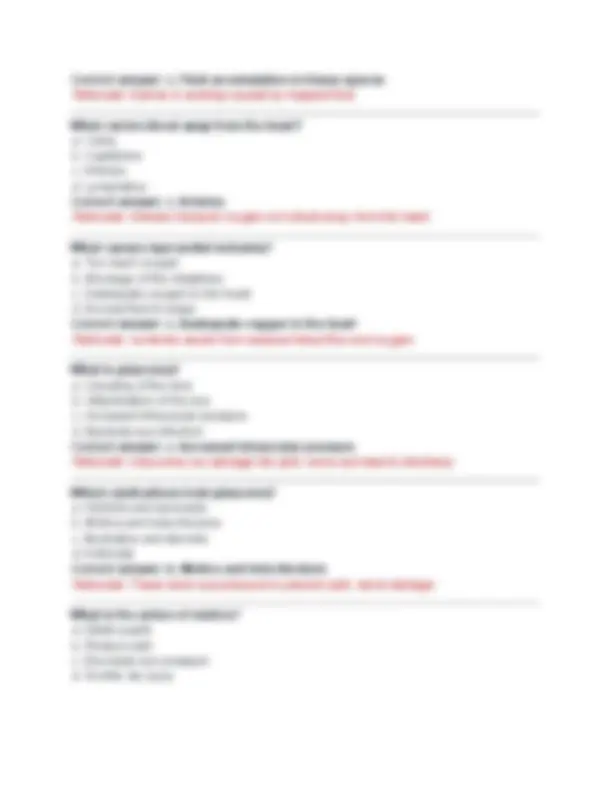
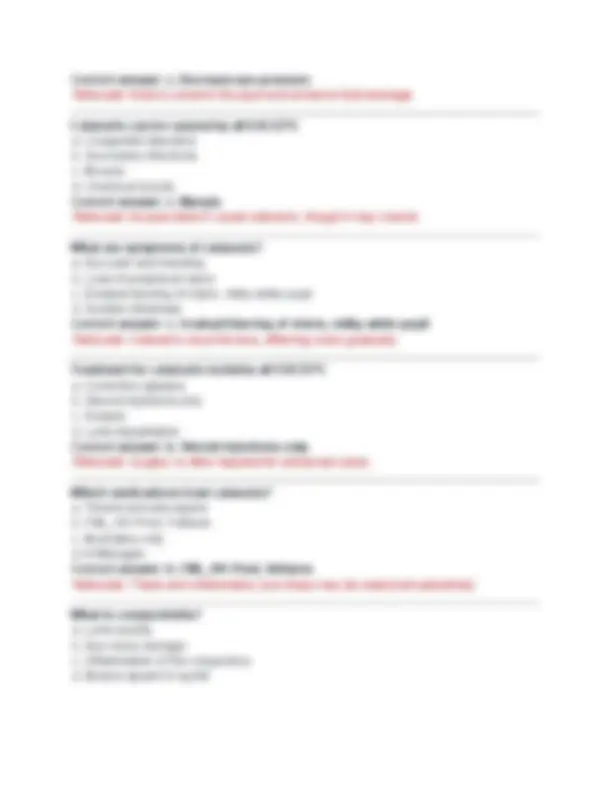
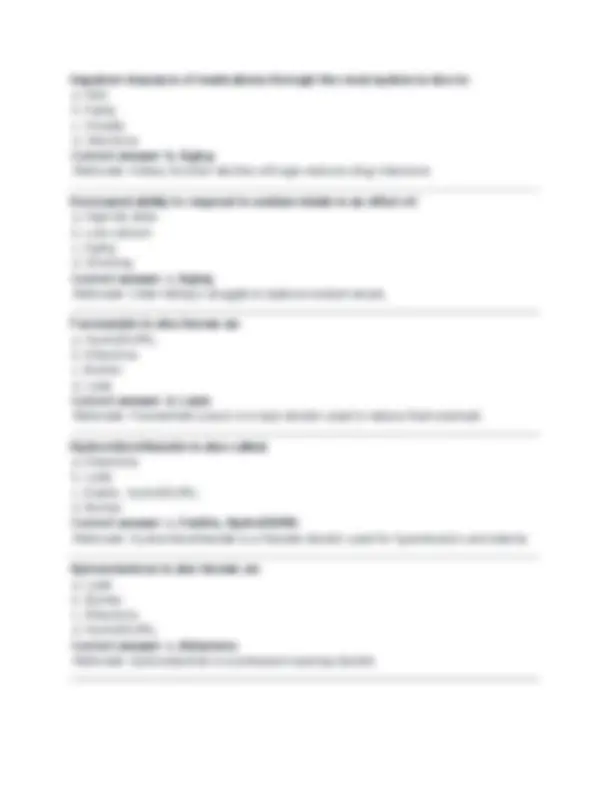
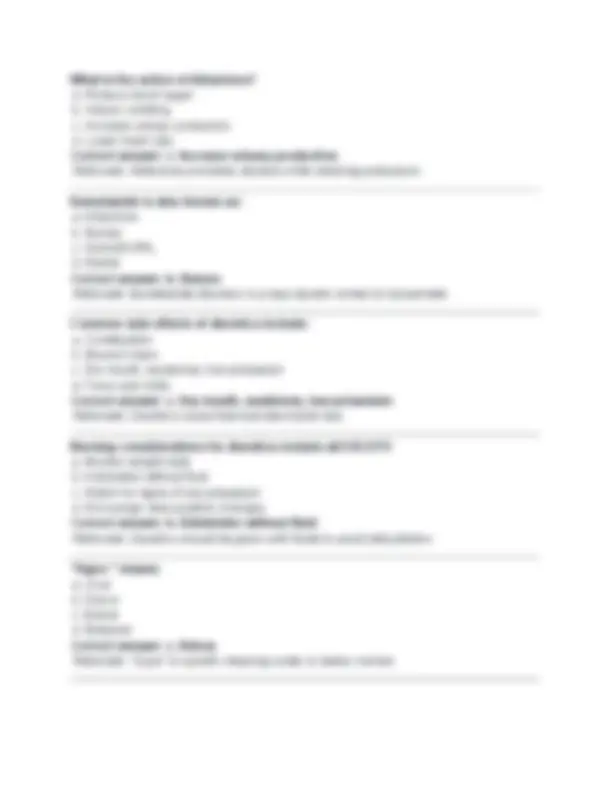
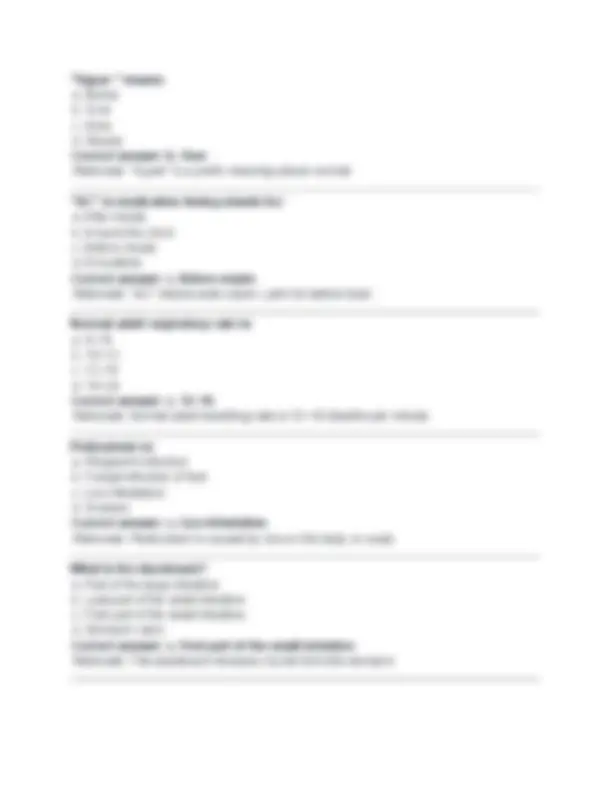
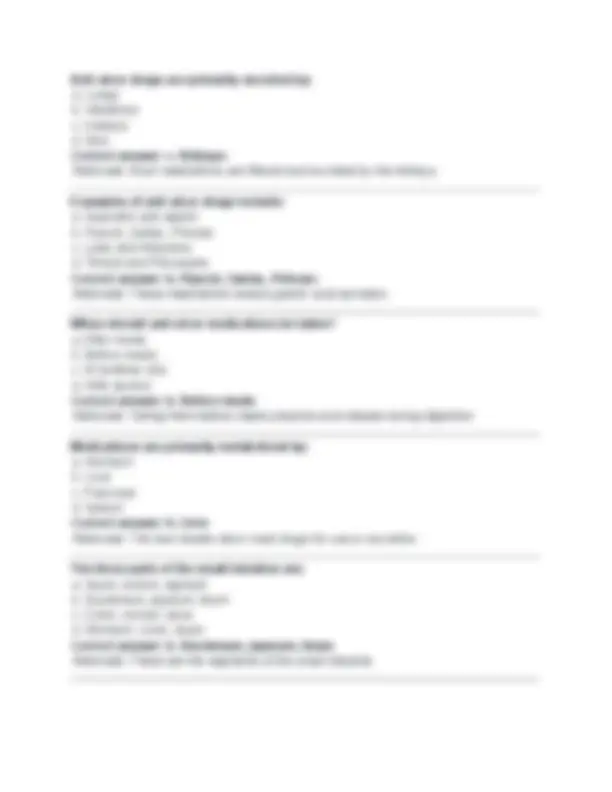
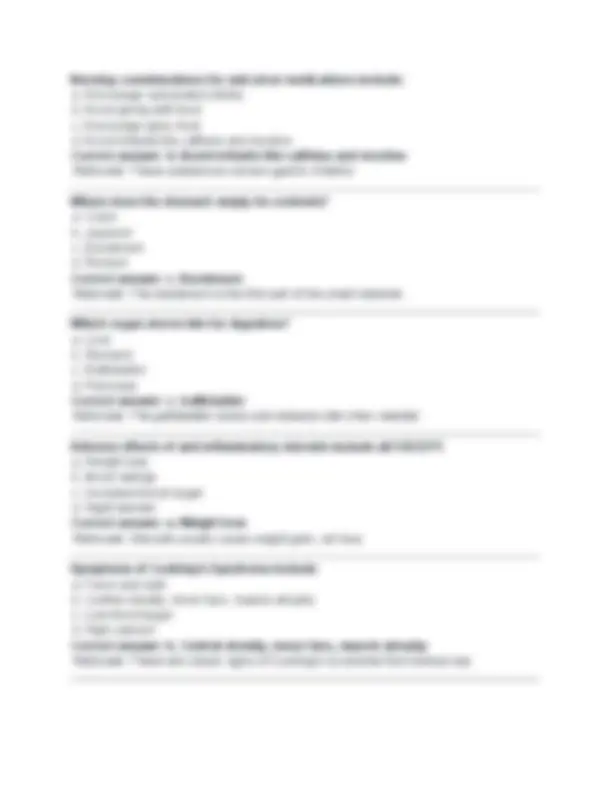
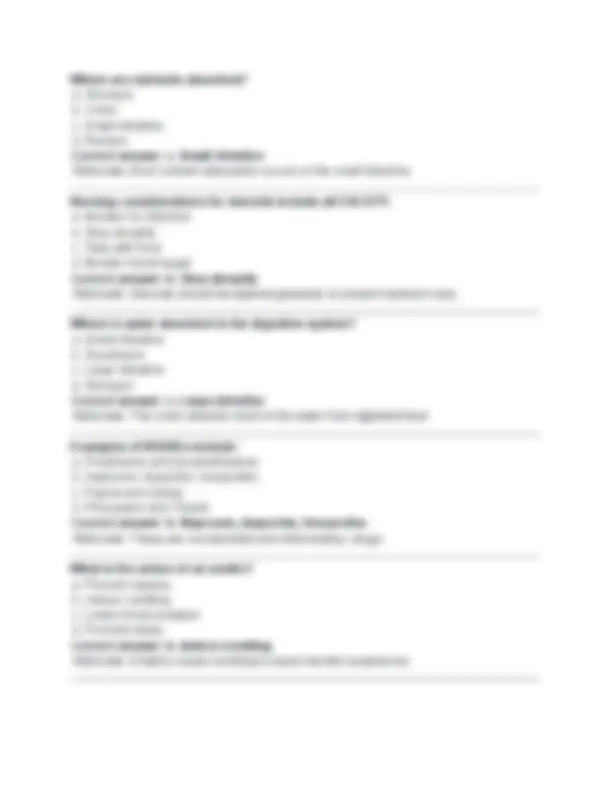
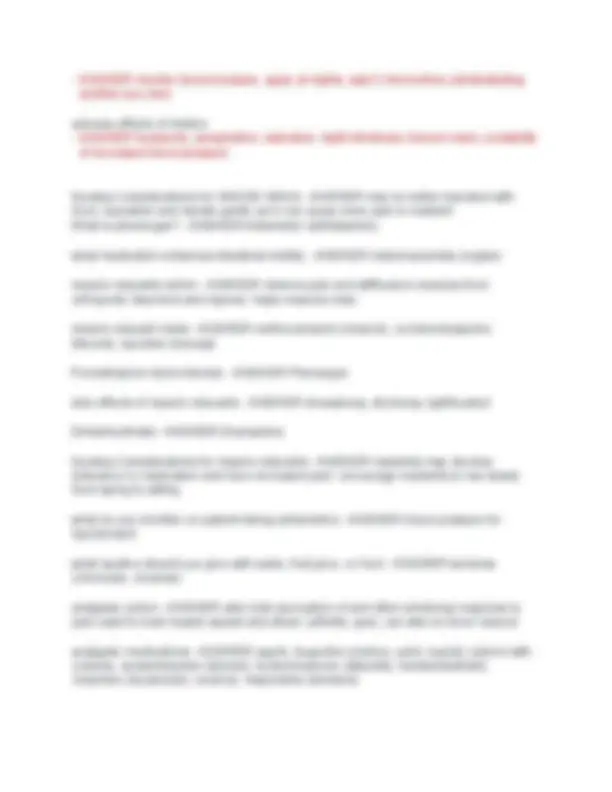
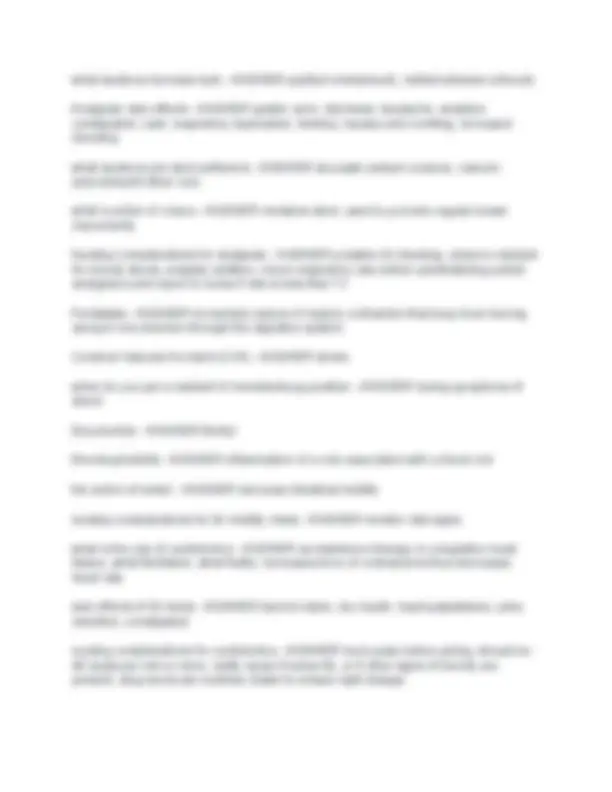

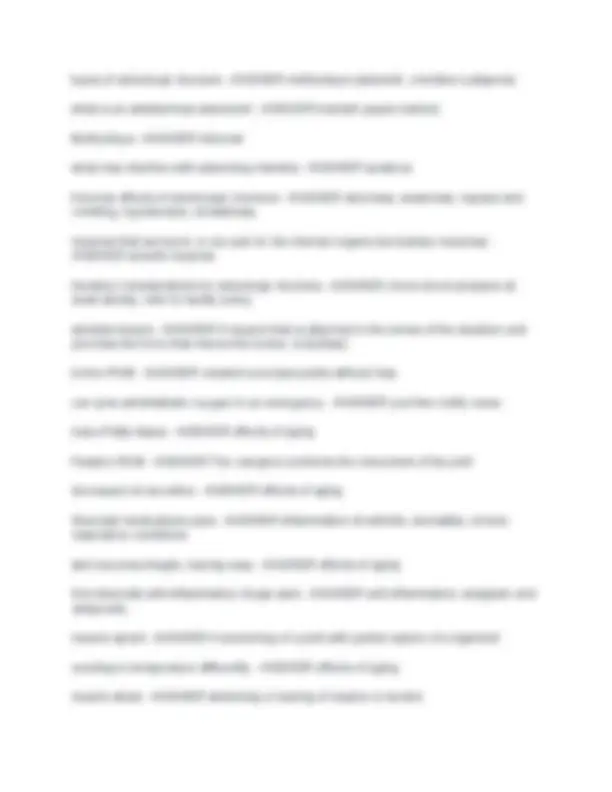
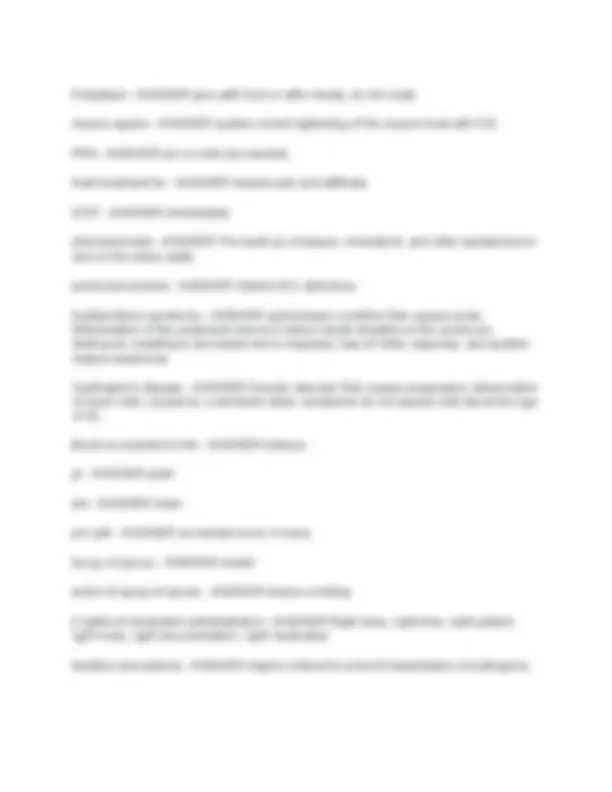
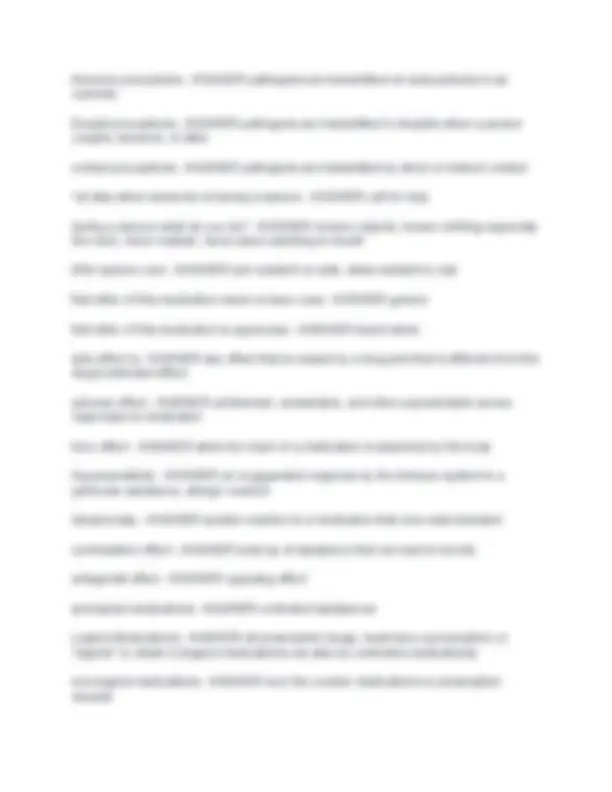
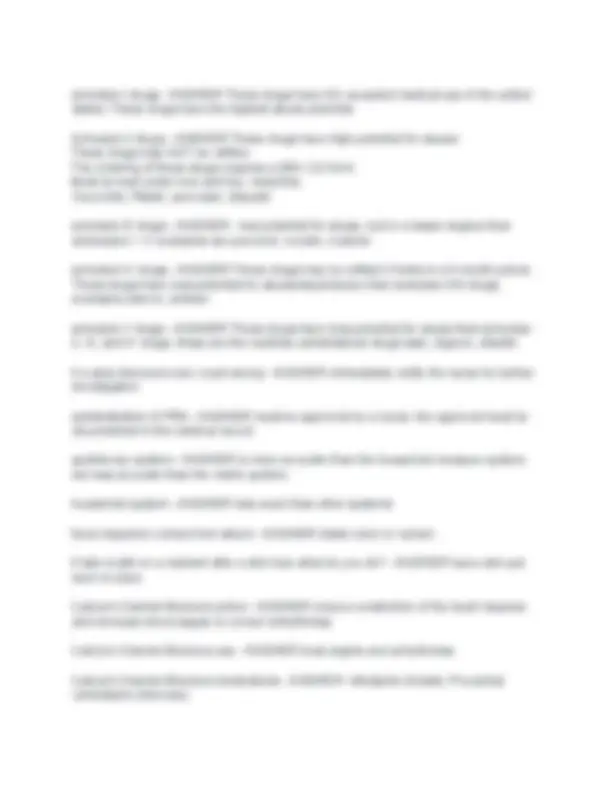
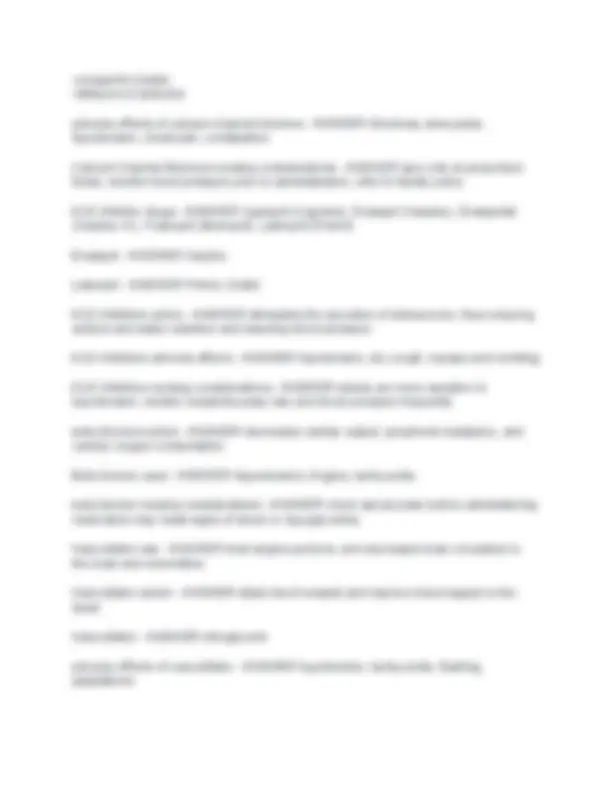
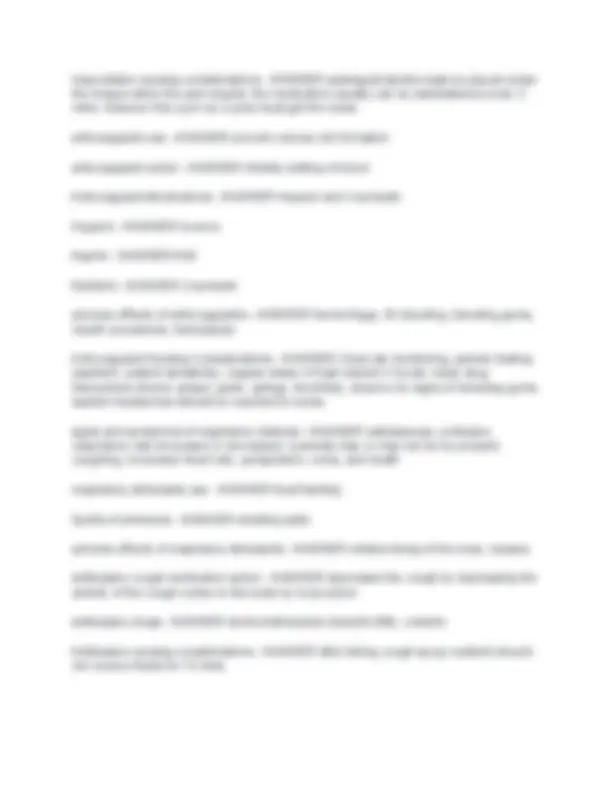
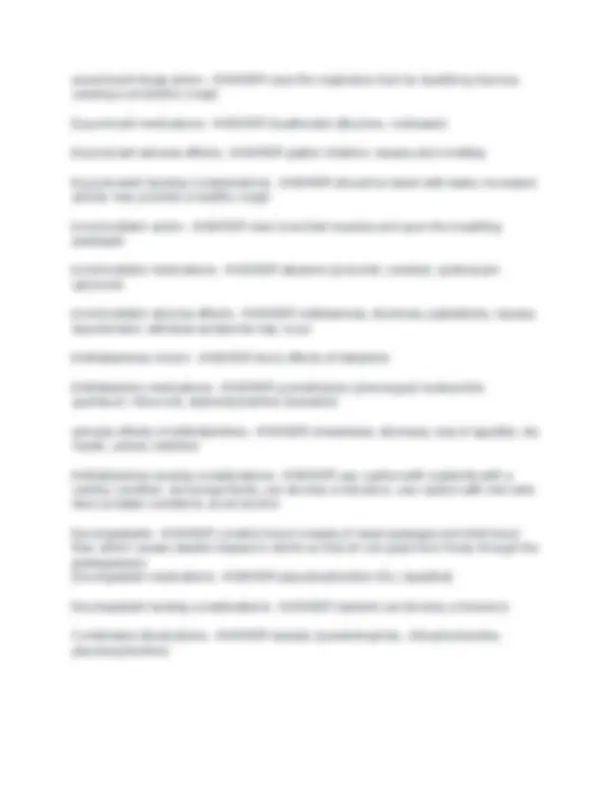
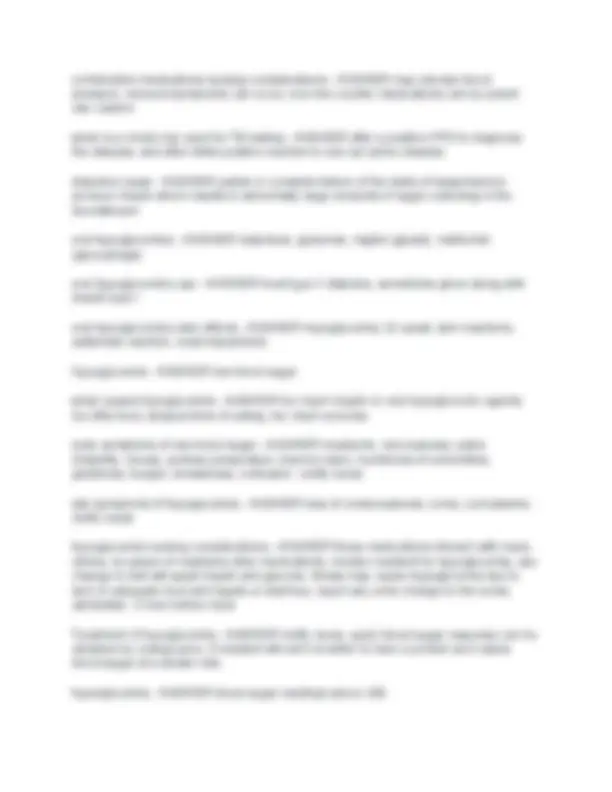
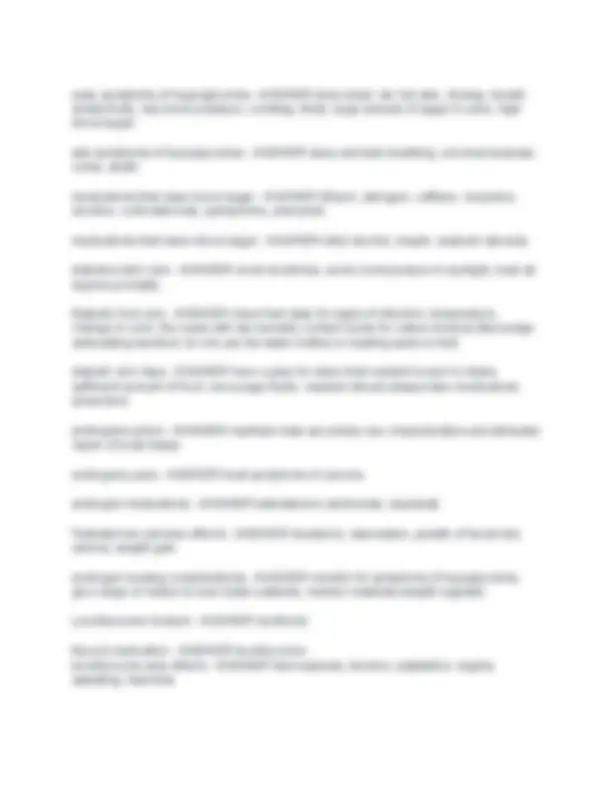
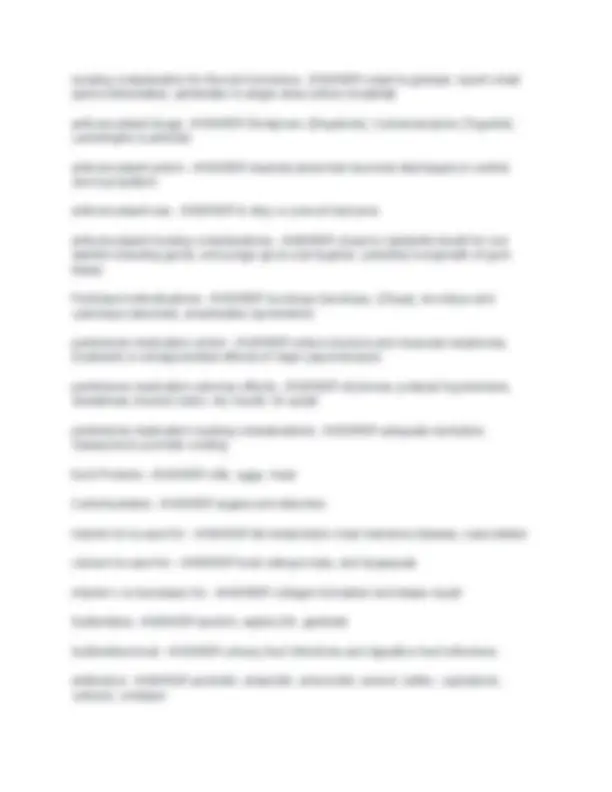
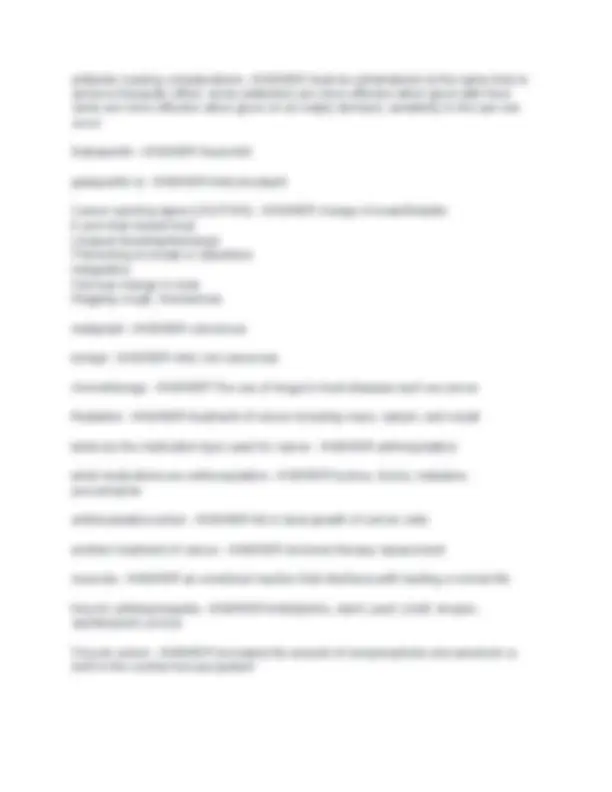
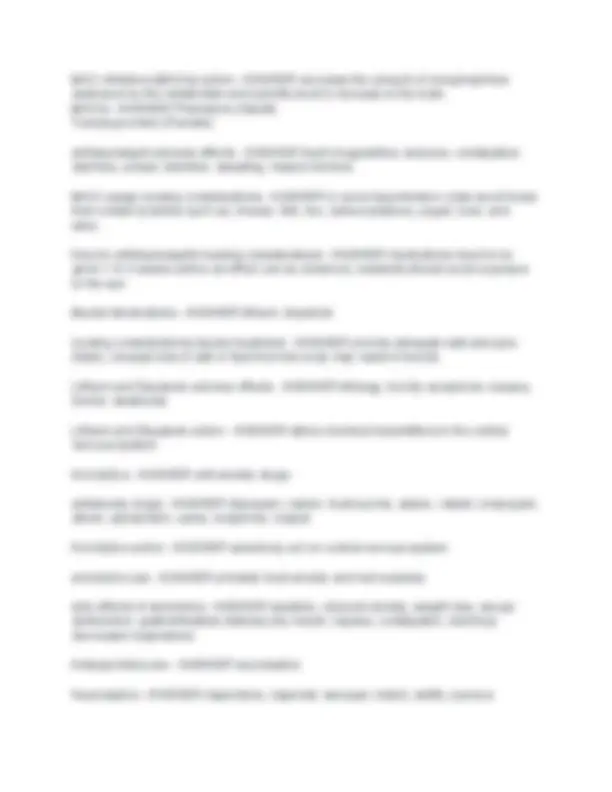
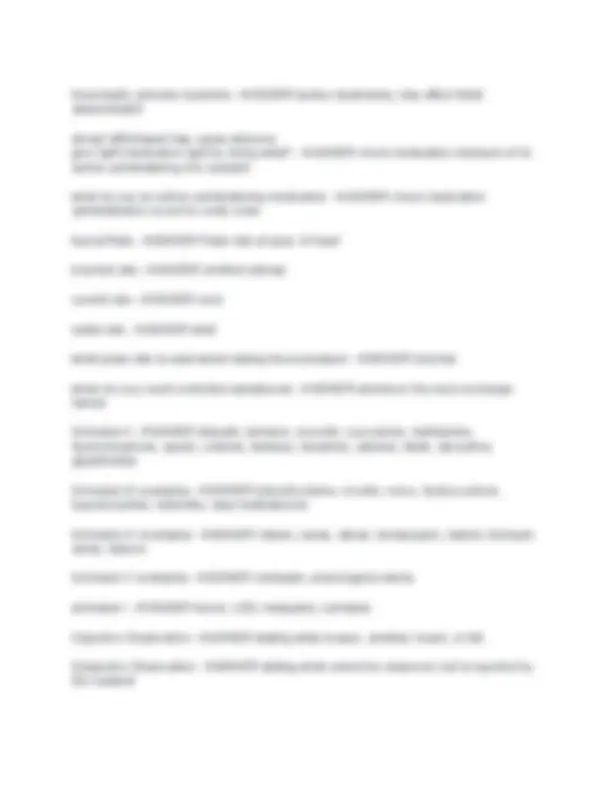
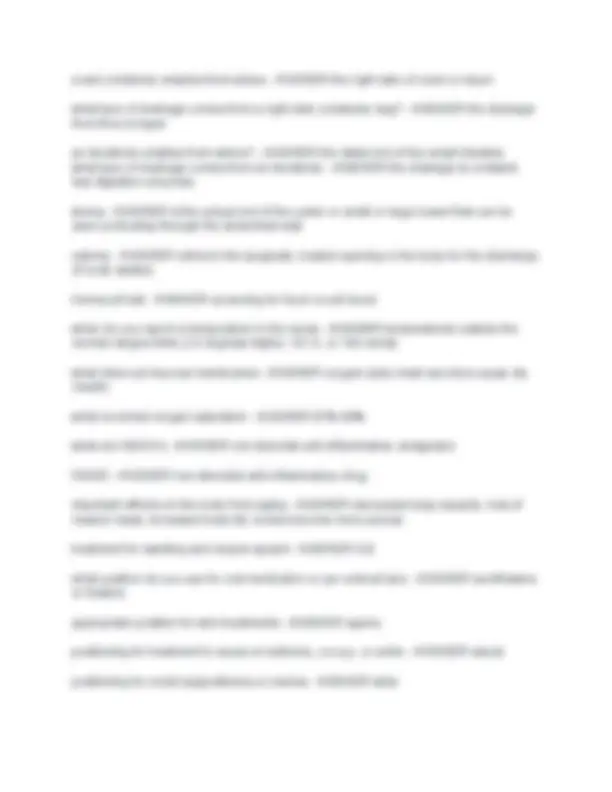
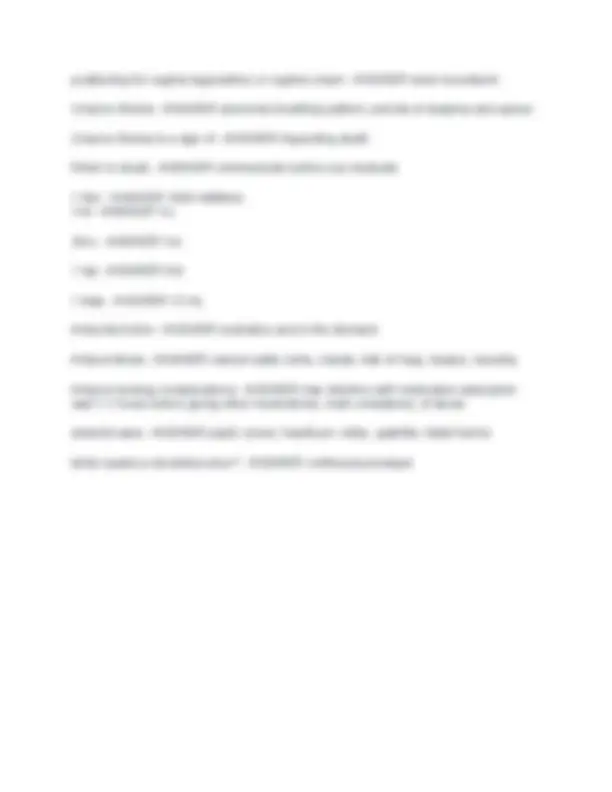


Study with the several resources on Docsity

Earn points by helping other students or get them with a premium plan


Prepare for your exams
Study with the several resources on Docsity

Earn points to download
Earn points by helping other students or get them with a premium plan
Community
Ask the community for help and clear up your study doubts
Discover the best universities in your country according to Docsity users
Free resources
Download our free guides on studying techniques, anxiety management strategies, and thesis advice from Docsity tutors
What does optic beta blockers treat? a. Cataracts b. Dry eyes c. Glaucoma d. Conjunctivitis Correct answer: c. Glaucoma Rationale: Optic beta blockers reduce intraocular pressure, which helps manage glaucoma. Which of the following is an optic beta blocker? a. Pilocarpine b. Timolol maleate (Timoptic) c. Prednisolone d. Diclofenac Correct answer: b. Timolol maleate (Timoptic) Rationale: Timolol maleate is a beta-blocker used to treat elevated intraocular pressure in glaucoma. What is the action of Timolol maleate (Timoptic solution)? a. Dilates pupils b. Reduces inflammation c. Increases tear production d. Lowers intraocular pressure Correct answer: d. Lowers intraocular pressure Rationale: Timolol decreases fluid production in the eye, reducing pressure. Which of the following is an adverse effect of optic beta blockers? a. Pupil dilation b. Eye irritation and blurred vision c. Increased heart rate d. Diarrhea Correct answer: b.
Typology: Exams
1 / 35

This page cannot be seen from the preview
Don't miss anything!




























What does optic beta blockers treat? a. Cataracts b. Dry eyes c. Glaucoma d. Conjunctivitis Correct answer: c. Glaucoma Rationale: Optic beta blockers reduce intraocular pressure, which helps manage glaucoma. Which of the following is an optic beta blocker? a. Pilocarpine b. Timolol maleate (Timoptic) c. Prednisolone d. Diclofenac Correct answer: b. Timolol maleate (Timoptic) Rationale: Timolol maleate is a beta-blocker used to treat elevated intraocular pressure in glaucoma. What is the action of Timolol maleate (Timoptic solution)? a. Dilates pupils b. Reduces inflammation c. Increases tear production d. Lowers intraocular pressure Correct answer: d. Lowers intraocular pressure Rationale: Timolol decreases fluid production in the eye, reducing pressure. Which of the following is an adverse effect of optic beta blockers? a. Pupil dilation b. Eye irritation and blurred vision c. Increased heart rate d. Diarrhea
Correct answer: b. Eye irritation and blurred vision Rationale: Optic beta blockers can cause local eye irritation and systemic effects like reduced heart rate. What does "OD" indicate in eye medication administration? a. Both eyes b. Left eye c. Right eye d. Mouth Correct answer: c. Right eye Rationale: "OD" stands for "oculus dexter," meaning right eye. What does "OS" indicate? a. Right ear b. Left eye c. Both eyes d. Left ear Correct answer: b. Left eye Rationale: "OS" stands for "oculus sinister," meaning left eye. What does "OU" stand for in eye medication? a. Right eye b. Left eye c. Both eyes d. Outer ear Correct answer: c. Both eyes Rationale: "OU" stands for "oculus uterque," meaning both eyes. What do mydriatics do for the eye? a. Constrict the pupil b. Decrease intraocular pressure c. Dilate the pupil d. Soothe eye irritation Correct answer: c. Dilate the pupil Rationale: Mydriatics are medications that dilate the pupil (D for dilate). What is the action of optic lubricants? a. Prevent infection b. Dilate pupils c. Soothes and lubricates dry eyes d. Reduce intraocular pressure
Correct answer: c. Fluid accumulation in tissue spaces Rationale: Edema is swelling caused by trapped fluid. What carries blood away from the heart? a. Veins b. Capillaries c. Arteries d. Lymphatics Correct answer: c. Arteries Rationale: Arteries transport oxygen-rich blood away from the heart. What causes myocardial ischemia? a. Too much oxygen b. Blockage of the intestines c. Inadequate oxygen to the heart d. Excess fluid in lungs Correct answer: c. Inadequate oxygen to the heart Rationale: Ischemia results from reduced blood flow and oxygen. What is glaucoma? a. Clouding of the lens b. Inflammation of the eye c. Increased intraocular pressure d. Bacterial eye infection Correct answer: c. Increased intraocular pressure Rationale: Glaucoma can damage the optic nerve and lead to blindness. Which medications treat glaucoma? a. NSAIDs and lubricants b. Miotics and beta blockers c. Mydriatics and steroids d. Antivirals Correct answer: b. Miotics and beta blockers Rationale: These lower eye pressure to prevent optic nerve damage. What is the action of miotics? a. Dilate pupils b. Reduce pain c. Decrease eye pressure d. Soothe dry eyes
Correct answer: c. Decrease eye pressure Rationale: Miotics constrict the pupil and enhance fluid drainage. Cataracts can be caused by all EXCEPT: a. Congenital disorders b. Secondary infections c. Myopia d. Chemical toxicity Correct answer: c. Myopia Rationale: Myopia doesn’t cause cataracts, though it may coexist. What are symptoms of cataracts? a. Eye pain and bleeding b. Loss of peripheral vision c. Gradual blurring of vision, milky white pupil d. Sudden blindness Correct answer: c. Gradual blurring of vision, milky white pupil Rationale: Cataracts cloud the lens, affecting vision gradually. Treatment for cataracts includes all EXCEPT: a. Corrective glasses b. Steroid injections only c. Surgery d. Lens implantation Correct answer: b. Steroid injections only Rationale: Surgery is often required for advanced cases. Which medications treat cataracts? a. Timolol and pilocarpine b. FML, AK-Pred, Voltaren c. Mydriatics only d. Antifungals Correct answer: b. FML, AK-Pred, Voltaren Rationale: These anti-inflammatory eye drops may be used post-operatively. What is conjunctivitis? a. Lens opacity b. Eye nerve damage c. Inflammation of the conjunctiva d. Muscle spasm in eyelid
A decline in the rate of kidney filtration is an effect of: a. Dehydration b. High protein diet c. Aging d. Infection Correct answer: c. Aging Rationale: Kidney function declines naturally with age, affecting filtration. A 53% decrease in renal blood flow is caused by: a. Hypertension b. Diabetes c. Aging d. Kidney stones Correct answer: c. Aging Rationale: Blood flow to the kidneys diminishes as part of the aging process. A decrease in size and number of functioning nephrons is an effect of: a. Medication use b. Obesity c. Aging d. Smoking Correct answer: c. Aging Rationale: The number and function of nephrons decline with age. What causes weakening bladder muscles and urinary retention? a. Bladder cancer b. Aging c. Diabetes d. Infection Correct answer: b. Aging Rationale: Aging affects the muscles involved in bladder control. Diminished kidney size is an effect of: a. Infection b. Dehydration c. Aging d. Alcohol use Correct answer: c. Aging Rationale: Kidneys shrink with age, affecting function.
Impaired clearance of medications through the renal system is due to: a. Diet b. Aging c. Obesity d. Infections Correct answer: b. Aging Rationale: Kidney function decline with age reduces drug clearance. Decreased ability to respond to sodium intake is an effect of: a. High-fat diets b. Low calcium c. Aging d. Smoking Correct answer: c. Aging Rationale: Older kidneys struggle to balance sodium levels. Furosemide is also known as: a. HydroDIURIL b. Aldactone c. Bumex d. Lasix Correct answer: d. Lasix Rationale: Furosemide (Lasix) is a loop diuretic used to reduce fluid overload. Hydrochlorothiazide is also called: a. Aldactone b. Lasix c. Esidrix, HydroDIURIL d. Bumex Correct answer: c. Esidrix, HydroDIURIL Rationale: Hydrochlorothiazide is a thiazide diuretic used for hypertension and edema. Spironolactone is also known as: a. Lasix b. Bumex c. Aldactone d. HydroDIURIL Correct answer: c. Aldactone Rationale: Spironolactone is a potassium-sparing diuretic.
"Hyper-" means: a. Below b. Over c. Slow d. Steady Correct answer: b. Over Rationale: “Hyper” is a prefix meaning above normal. "AC" in medication timing stands for: a. After meals b. Around the clock c. Before meals d. At bedtime Correct answer: c. Before meals Rationale: “AC” means ante cibum, Latin for before food. Normal adult respiratory rate is: a. 8– 10 b. 10– 12 c. 12– 16 d. 18– 24 Correct answer: c. 12– 16 Rationale: Normal adult breathing rate is 12–16 breaths per minute. Pediculosis is: a. Ringworm infection b. Fungal infection of feet c. Lice infestation d. Scabies Correct answer: c. Lice infestation Rationale: Pediculosis is caused by lice on the body or scalp. What is the duodenum? a. Part of the large intestine b. Last part of the small intestine c. First part of the small intestine d. Stomach valve Correct answer: c. First part of the small intestine Rationale: The duodenum receives chyme from the stomach.
Scabies is a: a. Bacterial infection b. Fungal infection c. Contagious skin disease from itch mite d. Viral rash Correct answer: c. Contagious skin disease from itch mite Rationale: Caused by mites that burrow under the skin. The jejunum is the: a. First part of the large intestine b. Second part of the small intestine c. Middle of the stomach d. Part of the colon Correct answer: b. Second part of the small intestine Rationale: The jejunum follows the duodenum in digestion. How long should you wash your hands? a. 5 seconds b. 10 seconds c. 20–30 seconds d. 1 minute Correct answer: c. 20–30 seconds Rationale: Proper hand hygiene requires at least 20 seconds. Where should you aim a fire extinguisher? a. At the flames b. At the ceiling c. At the smoke d. At the base of the fire Correct answer: d. At the base of the fire Rationale: Aim at the base where the fuel source is. The ileum is the: a. First part of the colon b. Middle part of the stomach c. Third part of the small intestine d. Upper esophagus Correct answer: c. Third part of the small intestine Rationale: The ileum connects to the large intestine.
Anti-ulcer drugs are primarily excreted by: a. Lungs b. Intestines c. Kidneys d. Skin Correct answer: c. Kidneys Rationale: Most medications are filtered and excreted by the kidneys. Examples of anti-ulcer drugs include: a. Ibuprofen and aspirin b. Pepcid, Zantac, Prilosec c. Lasix and Aldactone d. Timolol and Pilocarpine Correct answer: b. Pepcid, Zantac, Prilosec Rationale: These medications reduce gastric acid secretion. When should anti-ulcer medications be taken? a. After meals b. Before meals c. At bedtime only d. With alcohol Correct answer: b. Before meals Rationale: Taking them before meals prevents acid release during digestion. Medications are primarily metabolized by: a. Stomach b. Liver c. Pancreas d. Spleen Correct answer: b. Liver Rationale: The liver breaks down most drugs for use or excretion. The three parts of the small intestine are: a. Ileum, rectum, sigmoid b. Duodenum, jejunum, ileum c. Colon, rectum, anus d. Stomach, colon, ileum Correct answer: b. Duodenum, jejunum, ileum Rationale: These are the segments of the small intestine.
Nursing considerations for anti-ulcer medications include: a. Encourage carbonated drinks b. Avoid giving with food c. Encourage spicy food d. Avoid irritants like caffeine and nicotine Correct answer: d. Avoid irritants like caffeine and nicotine Rationale: These substances worsen gastric irritation. Where does the stomach empty its contents? a. Colon b. Jejunum c. Duodenum d. Rectum Correct answer: c. Duodenum Rationale: The duodenum is the first part of the small intestine. Which organ stores bile for digestion? a. Liver b. Stomach c. Gallbladder d. Pancreas Correct answer: c. Gallbladder Rationale: The gallbladder stores and releases bile when needed. Adverse effects of anti-inflammatory steroids include all EXCEPT: a. Weight loss b. Mood swings c. Increased blood sugar d. Night sweats Correct answer: a. Weight loss Rationale: Steroids usually cause weight gain, not loss. Symptoms of Cushing’s Syndrome include: a. Fever and rash b. Central obesity, moon face, muscle atrophy c. Low blood sugar d. High calcium Correct answer: b. Central obesity, moon face, muscle atrophy Rationale: These are classic signs of Cushing’s Syndrome from steroid use.
What do antiemetics do? a. Induce vomiting b. Increase heart rate c. Suppress nausea and vomiting d. Raise blood sugar Correct answer: c. Suppress nausea and vomiting Rationale: Antiemetics act on brain centers to prevent nausea. Adverse effects of NSAIDs include all EXCEPT: a. GI bleeding b. Tinnitus c. Fatigue d. Hyperglycemia Correct answer: d. Hyperglycemia Rationale: Hyperglycemia is not a common NSAID side effect; it's more linked to steroids An antiemetic is used to: a. Promote vomiting b. Suppress nausea and vomiting c. Stimulate digestion d. Increase appetite Correct answer: b. Suppress nausea and vomiting Rationale: Antiemetics reduce nausea and prevent or stop vomiting. Compazine and Tigan are examples of: a. Laxatives b. Antihistamines c. Antiemetics d. Antacids Correct answer: c. Antiemetics Rationale: Both are medications used to treat nausea and vomiting. Side effects of antiemetics include: a. Hyperactivity b. Constipation c. Drowsiness and dry mouth d. Diarrhea and vomiting Correct answer: c. Drowsiness and dry mouth Rationale: These are common effects due to CNS depression.
Nursing considerations for antiemetics include: a. Give with alcohol b. Encourage rapid movement c. Monitor for sedation d. Avoid giving with food Correct answer: c. Monitor for sedation Rationale: Antiemetics can cause drowsiness and dizziness. The main action of antacids is to: a. Stimulate acid production b. Neutralize stomach acid c. Decrease gastric motility d. Increase bile flow Correct answer: b. Neutralize stomach acid Rationale: Antacids raise the pH of stomach contents to relieve heartburn or indigestion. Milk of Magnesia is classified as: a. Proton pump inhibitor b. Antibiotic c. Antacid and laxative d. Anti-inflammatory Correct answer: c. Antacid and laxative Rationale: It neutralizes stomach acid and promotes bowel movements. A nursing consideration for Milk of Magnesia is: a. Administer with milk b. Mix with fruit juice c. Wait 1–2 hours after other meds d. Always give at bedtime Correct answer: c. Wait 1–2 hours after other meds Rationale: Antacids can interfere with absorption of other medications. Side effects of Milk of Magnesia include: a. Hypertension b. Constipation c. Diarrhea d. Insomnia Correct answer: c. Diarrhea Rationale: Milk of Magnesia draws water into the colon, leading to loose stools. what are nursing considerations for miotics?
what laxatives increase bulk - ANSWER psyllium (metamucil), methylcellulose (citrucel) Analgesic side effects - ANSWER gastric ulcer, dizziness, headache, sedation, constipation, rash, respiratory depression, tinnitus, nausea and vomiting, increased bleeding what laxatives are stool softeners - ANSWER docusate sodium (colace), calcium polycarbophil (fiber con) what is action of colace - ANSWER moistens stool, used to promote regular bowel movements Nursing Considerations for analgesic - ANSWER possible GI bleeding, observe resident for bloody stools, possibly additive, check respiratory rate before administering potent analgesics and report to nurse if rate is less than 12 Peristalsis - ANSWER Involuntary waves of muscle contraction that keep food moving along in one direction through the digestive system. Cerebral Vascular Accident (CVA) - ANSWER stroke when do you put a resident in trendelenburg position - ANSWER during symptoma of shock Dicyclomine - ANSWER Bentyl thrombophelbitis - ANSWER inflammation of a vein associated with a blood clot the action of bentyl - ANSWER decrease intestinal motility nursing considerations for GI motility meds - ANSWER monitor vital signs what is the use of cardiotonics - ANSWER as maintence therapy in congesfive heart failure, atrial fibrillation, atrial flutter, increases force of contractions thus decreases heart rate side effects of GI meds - ANSWER blurred vision, dry mouth, heart palpitations, urine retention, constipation nursing considerations for cardiotonics - ANSWER heck pulse before giving, should be 60 beats per min or more, notify nurse if below 60, or if other signs of toxicity are present, drug levels are routinely drawn to ensure right dosage
Senna - ANSWER Senokot cardiotonic med - ANSWER digoxin (lanoxin, lanoxicap) Bisacodyl - ANSWER Dulcolax action of digoxin - ANSWER slows and strengthens the heart rate action of carthartic laxatives - ANSWER stimulate intestinal peristalsis: usually 6 to 8 when given in oral form Propranolol - ANSWER Inderal side effects of laxatives - ANSWER abdominal cramping, nausea, diarrhea antiarrhythmic drugs action - ANSWER slows conduction to regulate heart rate and rhythm antiarrhythmic drugs - ANSWER propranolol (inderal), amiodarone (pacerone, cordarone), procainamide HCL (pronestyl) what is action of saline laxatives - ANSWER pull fluid to large intestines Saline Laxatives - ANSWER milk of magnesia Adverse effects of antiarrhythmics - ANSWER slow pulse rate, postural hypotension, dizziness, may lower blood pressure antiarrhythmic nursing considerations - ANSWER administer 1 hr before or 2 hrs after meals with full glass of water, check pulse routinely, report any effects to nurse immediately, monitor blood pressure Nursing Considerations for milk of mag - ANSWER shake well, monitor for good fluid intake Adrenergic Blockers use - ANSWER treat blood pressure Bismuth - ANSWER Pepto Bismol adrenergic blockers action - ANSWER decrease blood pressure by having an effect on the nervous system and dilating blood vessels action of antidiarrheal absorbents - ANSWER absorb excess fluids and bacteria